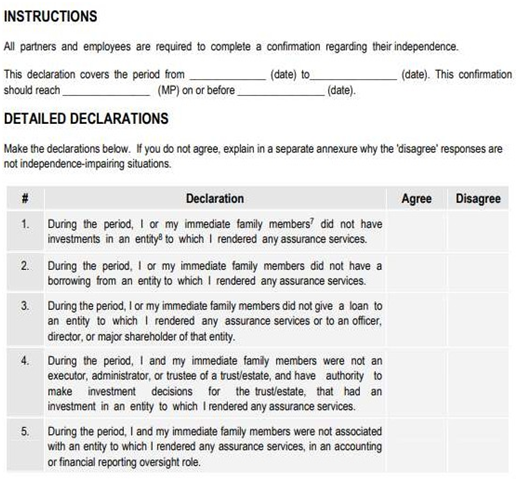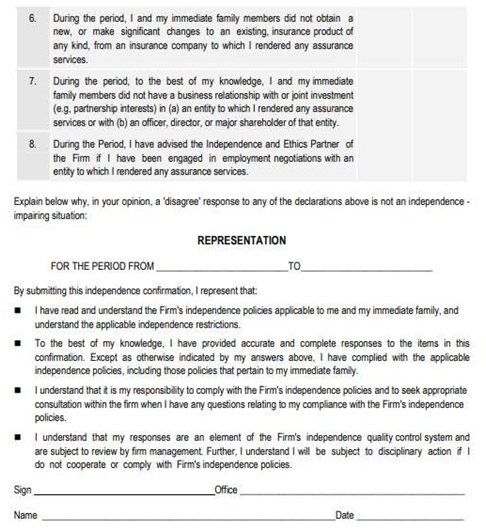SQC 1 deals with the firm's responsibility for having a system of quality management. The SQC is the mechanism that creates an environment that enables and supports engagement teams in performing quality engagements. It helps the firm in achieving consistent engagement quality because it is focused on how the firm manages the quality of engagements performed.
Objectives of the standard
- The firm is to establish and maintain a system of quality control
- That quality control system provides reasonable assurance that e firm and its personnel comply with professional standards and applicable legal and regulatory requirements
- Reports issued by the firm or engagement partners are appropriate in the circumstances
Components of SQC-1
- Leadership responsibilities for quality within the firm
- Ethical requirements
- Acceptance and continuance of client relationships and specific engagements
- Human resources
- Engagement performance
- Monitoring
We will cover first 4 components in this post. Let's understand each component in detail.

1. Leadership responsibilities for quality within the firm
Performing quality work begins with strong leadership within the firm and engagement partners committed to the highest ethical standards.
The provision of quality audits and related services is vital to:
- Safeguarding the public interest;
- Maintaining client satisfaction;
- Delivering value for money;
- Ensuring compliance with professional standards; and
- Establishing and maintaining a professional reputation.
Delivery of high-quality and cost-effective services is the principal driver of success for professional audit firms. Quality service is also vital in relation to the public-interest responsibilities of professional accountants.
The provision of quality services should always be a key objective in the firm's business strategy; that objective needs to be communicated to all personnel on a regular basis, and the results monitored. This requires leadership and accountability for promised actions.
Poor quality control can lead to inappropriate opinions, poor client service, lawsuits, and loss of reputation. Below are some of the points that limit/ resist the quality of the service provided:
|
Limitation |
Description |
|||||
|
Poor Attitudes |
A poor attitude is at the heart of most hindrances to quality. It includes such attitudes (but not necessarily this extreme) as the following:
|
|||||
|
Unwillingness Development |
to |
Invest |
in |
Training |
or |
Conducting a quality audit is dependent on attracting and retaining qualified and competent people to perform the work. This requires ongoing professional development and performance appraisals for all partners and professional staff (every period). Lack of investment in staff also leads to staff turnover. |
|
Lack of Discipline |
A failure to discipline partners or staff when the firm's policies are wilfully contravened sends a very clear message to personnel that written policies are really not that important. This undermines compliance with all of the firm's policies and increases the risk to the firm |
|||||
A strong tone at top can be set by firm's management and engagement partners through the following:
|
Setting tone at top |
Description |
|
Establish the Firm's Objectives, Priorities, and Values |
This could include:
|
|
Communicate Regularly |
Reinforce the firm's values and commitments by communicating regularly (verbally and in writing) with staff. Communications would address the need for integrity, objectivity, independence, professional skepticism, staff development, and accountability to the public. Communications could be made through the Performance-appraisal system, partner updates, emails, office meetings, and internal newsletters. |
|
Update the Quality Control Manual |
Each period, update the firm's quality control policies and procedures to address weaknesses and any new requirements |
|
Hold People Accountable |
Assign clear responsibilities and accountabilities for quality-control functions (such as independence issues, consultation, file review, etc.). |
|
Develop Staff Competence and Reward Quality Work |
Develop staff through:
|
|
Continually Improve |
Take prompt action to correct deficiencies when identified, such as through the firm's engagement file monitoring, including the cyclical inspection of completed engagement files. |
|
Set an Example |
Provide staff with a role model in the positive example set by partners in their day-to-day behaviour. For example, if a policy emphasizes the need for quality work, a staff member should then not be criticized for legitimately going over the budgeted time |
2. Ethical requirements
The firm should establish policies and procedures designed to provide it with reasonable assurance that the firm, its personnel and, where applicable, others (such as experts employed/engaged by the firm) subject to independence requirements.
This can be done in following way:
|
Mode of implementation |
Description |
|
Communication |
|
|
Identify and evaluate circumstances and relationships that create threats to independence |
|
|
Reporting by staff/ partners |
|
|
Maintaining a database of independence |
|
- The firm should establish a system in such a manner that it is notified of breaches of independence requirements, and to enable it to take appropriate actions to resolve such situations.
- All who are subject to independence requirements to promptly notify the firm of independence breaches of which they become aware.
- For this, a firm can draft an Independence Policy to cover aspects required by this SQC.
- As per Para 23 of SQC-1, "At least annually, the firm should obtain written confirmation of compliance with its policies and procedures on independence from all firm personnel required to be independent in terms of the requirements of the Code". Following is the format given by ICAI in its implementation guide on SQC-1.


- The above independence confirmation can be obtained in paper format or electronic format such as over email or Google forms etc. Further, to strengthen the independence process, the firm should obtained it before starting any engagement.
3. Acceptance and continuance of client relationships and specific engagements:
One of the most important decisions that a firm can make is determining what engagements to accept or which client relationships to retain. A poor decision can lead to unbillable time, unpaid fees, additional stress on partners and staff, loss of reputation, and, worst of all, potential lawsuits.
SQC 1 and SA 220 require firms to develop, implement, and document their quality control procedures in regard to their client acceptance and retention policies. Ideally, these policies and procedures should address the level of risk and the client characteristics (such as poor management integrity, a high-risk industry, or a publicly-traded company) that would not be acceptable to the firm.
It is to be noted that as per SA 220 the audit file must contain client/engagement acceptance and/or continuance details.
The following table givens an illustrative list of questionnaire before accepting a new client:
|
Consider |
Line of inquiry |
|
The Firm's Quality Control Requirements |
What policies and procedures are in place to provide reasonable assurance that the firm will only undertake or continue relationships where:
|
|
What Work Is Required? |
|
|
Does the Firm Have the Competence, Resources, and Time Required? |
|
|
Is the Firm Independent? |
|
|
|
|
Are the Risks Involved Acceptable? |
|
|
|
|
Can the Client Be Trusted? |
|
In addition to above, ICAI has in its implementation guide on SQC-1 has given illustrative format of Client/ Engagement Acceptance/ Continuance Form which can be access from this link (Microsoft Word - Implementation Guide to SQC 1-INITIAL PAGES.doc (icai.org) on Page No. 50.
4. Human resources:
The firm should establish policies and procedures designed to provide it with reasonable assurance that it has sufficient personnel with the capabilities, competence, and commitment to ethical principles necessary to perform its engagements in accordance with professional standards and regulatory and legal requirements. Such policies includes:
- Recruitment
- Performance evaluation
- Capabilities, including time to perform assignments
- Competence
- Career development
- Promotion
- Compensation
- The estimation of personnel needs It can be done through following mechanism:
|
Policy aspects |
How it can be implemented |
|
Recruitment |
|
|
Performance Evaluation |
|
|
Capabilities, including time to perform assignments |
|
|
|
|
Competence and Career development |
|
|
Promotion and Compensation |
|
We will cover other 2 components in next post. Hope you find this post helpful.







 CAclubindia
CAclubindia
